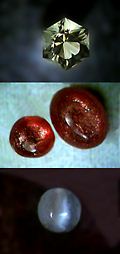![]()
Name:
Feldspar

Chem:
KAlSi3O8
- Orthoclase
KAlSi3O8
- Microcline
NaAlSi3O8-
CaAl2Si2O8
- Plagioclase
Crystal:
Orthoclase - monoclinic (prismatic crystals, often flat sided crystals)
Microcline - triclinic(prismatic, and often twinned)
Plagioclase - triclinic(often flat or tabular with striations)
Color:
Orthoclase - usually light colored white, pink, yellow, or cream, and not transparent. The gem variety is clear to pale yellow, and some called "noble orthoclase"
Microcline - white, pink, pale yellow, or sometimes green-blue, and not transparent. The green-blue variety is called "amazonite"
Plagioclase - gray to grayish-white is common, but may also be white, pink or pale yellow. More semi-opaque than the other feldspars on average, and contains striations on some crystal faces or cleavage surfaces.
Refrac. Index:
O 1.52-2.54,
M 1.52-1.53,
P 1.53-1.59
Birefraction:
O-0.005,
M-0.008,
P-0.010
Hardness:
6-6.5
Spec. Grav.:
(O-M)-2.56 ,
P-2.64-2.70
Fracture:
All-uneven
Cleavage:
All-perfect
Environment:
the feldspars make up the major constituent of many igneous and metamorphic rocks, they form at medium to high temperature and at some depth. Microcline can form in granite pegmatites and at lower temperatures.
Association:
quartz, other feldspars, hornblende
Locals:
| all over the world Amazonite-Brazil, Col., USA | Labradorite - Labrador, Norway | Sunstone - Ore., USA | Gem Orthoclase - Madagascar |
Misc:
The word comes from the German "feldt spat", meaning "field spar", "spar" meaning common clevable material - the material dredged up on farm lands during plowing. Most of them are not affected by acid (exception the Ca rich plagioclase - Anorthite). Orthoclase got is name from the Greek phrase meaning "straight fracture", Microcline from a Greek phrase meaning "small incline", and Plagioclase from the Greek phrase meaning "oblique fracture".
Gem info:
Orthoclase - when transparent it is faceted into a gemstone. Clear or pale yellow in color it is a collectors item, and of little value to the jewelry industry as both beryl and even citrene are harder and more durable.
Microcline - variety amazonite, is sometimes cut into cabochons, and used in jewelry. The blue-green color is caused by a lead impurity. It is rarely used as more people are aware of turquoise and chrysocolla.
Moonstone - moonstone can be made up of any number of different feldspars including, orthoclase, plagioclase, albite, and microcline. They are all very similar when cut into cabochons, they can best be distinguished by their different densities. Moonstone tends to be silver, pale green, pale blue, or creamy colored. It is translucent and shows a blue-white sheen sometimes called "adularescence".
Plagioclase - there are two distinct varieties used in jewelry, the dark-blue-black Labradorite, and the orange-honey colored Sunstone.
- Labradorite gets its coloring from a "labradorescence", reflected light from a multitude of small parallel, plate-like structures, with minute inclusions of ilmenite, rutile, and magnetite. The color patterns are similar in that shown in nature with oil on water. It is rarely faceted, but often cut into attractive cabochons. Value is not really very high as it has not caught on as a popular material and is abundant.
- Sunstone is a species of plagioclase called "oligoclase" or known sometimes in the jewelry industry as "adventurine feldspar". It gets is shiller in the same way that labradorite does, but the background color is brown to orange, and the composition is full of small hematite crystals that give it additional sparkle.
![]()
orthoclase
![]()
sunstone
![]()
moonstone
![]()
labradorite cabs
![]()
labradorite facet
![]()
amazonite